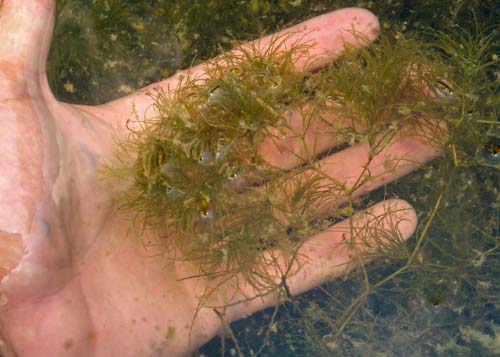Brittle Naiad
Brittle naiad (Najas minor) seems to prefer to grow within strands of other vegetation. Find these bright green clumps and flip into them. The plants are brittle and hangups will be less frequent.

Seasonal Techniques
Spring—Reliant mostly on seed for growth, this species germinates early in the spring and begins forming bushy patches. Being very brittle, you can fish nearly any technique through this species without hang-ups during spring. Yo-yo a trap or swimbait through stands of brittle naiad in spring.
Summer—Brittle naiad will being rapid growth in summer and produce new seed in August. Brittle naiad seems to prefer to grow within stands of other vegetation and will be found intermixed with all other species, often resembling bright green clumps amidst others. Find these bright green clumps and flip into them. The plants are brittle and hangups will be less frequent.
Fall—Brittle naiad begins to break up rapidly in the fall, much earlier than other species, so large stands of the plant will seem to disappear, opening up water more readily than other species.
Winter—Brittle naiad will die completely back, leaving only seed behind.
Habitat Value
Fish—Brittle naiad tends to grow among other species of vegetation, thus promoting habitat in transition zones between species.
Waterfowl—N/A
Identifying Features
What It Looks Like—Like other naiads, leaves are opposing and submersed. Brittle naiad leaves appear toothy and bushy, resembling bright green clumps in water.
Where to Find It—Look for brittle naiad in stagnant or slow-moving water, growing among other species. This species can be finicky, changing in distribution from year to year. The plant seems to grow well during years with little rain.
Max Depth—0 to 5 feet
Similar Species—Sago pondweed, which also can appear bushy, has alternating leaves, whereas brittle naiad has opposing leaves and is toothy in appearance.
Drawbacks
Invasive brittle naiad can grow to nuisance levels causing water use problems, but is relatively easy to manage if done before seed is produced. Cost to manage: $$ out of $$$$$.
Contact Us
We're always looking for more information about aquatic plants on TVA reservoirs. Let us know where and what you see, and send us your photos. Email us.